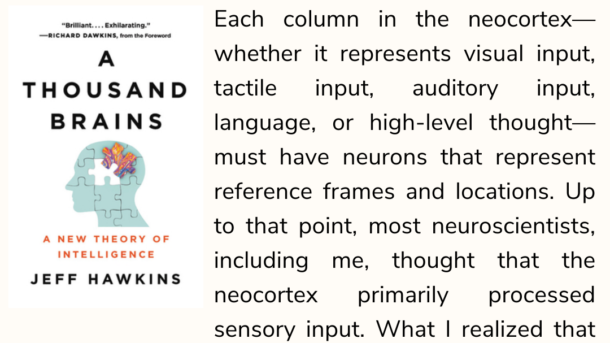Vision, I realized, is doing the same thing as touch. Patches of retina are analogous to patches of skin. Each patch of your retina sees only a small part of an entire object, in the same way that each patch of your skin touches only a small part of an object. The brain doesn’t process a picture; it starts with a picture on the back of the eye but then breaks it up into hundreds of pieces. It then assigns each piece to a location relative to the object being observed. Creating reference frames and tracking locations is not a trivial task. I knew it would take several different types of neurons and multiple layers of cells to make these calculations. Since the complex circuitry in every cortical column is similar, locations and reference frames must be universal properties of the neocortex. Each column in the neocortex—whether it represents visual input, tactile input, auditory input, language, or high-level thought—must have neurons that represent reference frames and locations. Up to that point, most neuroscientists, including me, thought that the neocortex primarily processed sensory input. What I realized that day is that we need to think of the neocortex as primarily processing reference frames. Most of the circuitry is there to create reference frames and track locations. Sensory input is of course essential. As I will explain in coming chapters, the brain builds models of the world by associating sensory input with locations in reference frames. Why are reference frames so important? What does the brain gain from having them? First, a reference frame allows the brain to learn the structure of something. A coffee cup is a thing because it is composed of a set of features and surfaces arranged relative to each other in space. Similarly, a face is a nose, eyes, and mouth arranged in relative positions. You need a reference frame to specify the relative positions and structure of objects. Second, by defining an object using a reference frame, the brain can manipulate the entire object at once. For example, a car has many features arranged relative to each other. Once we learn a car, we can imagine what it looks like from different points of view or if it were stretched in one dimension. To accomplish these feats, the brain only has to rotate or stretch the reference frame and all the features of the car rotate and stretch with it. Third, a reference frame is needed to plan and create movements. Say my finger is touching the front of my phone and I want to press the power button at the top. If my brain knows the current location of my finger and the location of the power button, then it can calculate the movement needed to get my finger from its current location to the desired new one. A reference frame relative to the phone is needed to make this calculation. Reference frames are used in many fields. Roboticists rely on them to plan the movements of a robot’s arm or body. Reference frames are also used in animated films to render characters as they move. A few people had suggested that reference frames might be needed for certain AI applications. But as far as I know, there had not been any significant discussion that the neocortex worked on reference frames, and that the function of most of the neurons in each cortical column is to create reference frames and track locations. Now it seems obvious to me.
Had to do a simple Wikipedia for this one. The normal Wikipedia explanation for Reference Frame was way too complex.
So the key message behind this is that setting reference frames is a universal property of your neocortex, whether it be used for touch, visual or audio. The parts of the brain that processes these sensory inputs are not that different. Key message is that they process reference frames.
So what are reference frames? Image seeing a ball rolling down a street. The houses behind it, the lights and the road itself are the reference frame. Without them, you won’t be able to actually see or recognise that the ball is rolling down.
And what does this mean? It means that if the different parts of our neocortex have a universal component or principle behind them, then we might be closer to understanding the common principle behind “intelligence”. Just like how DNA is a common strand among all of us that is a universal principle that yields wildly different results, we might be close to figuring out the “DNA” behind intelligence too.



